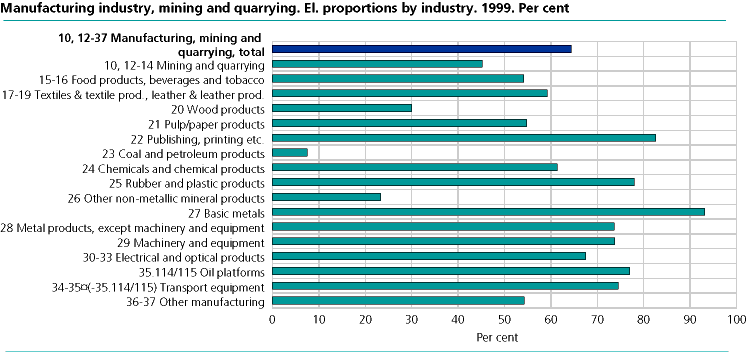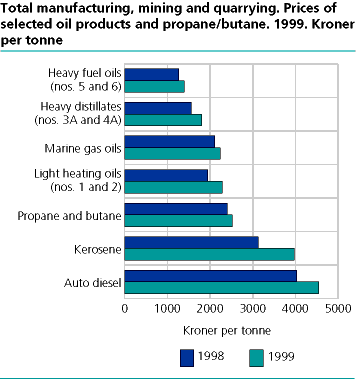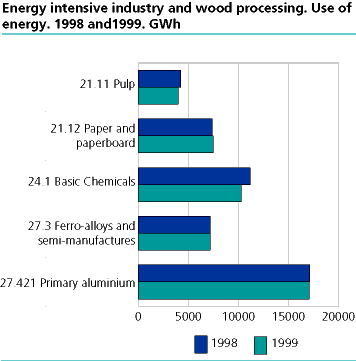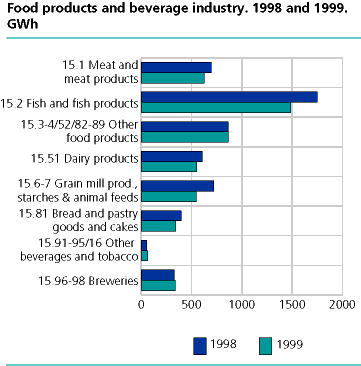Content
Published:
This is an archived release.
Energy use down by 2.4 per cent
In 1999 total energy use in manufacturing, mining and quarrying was 74 989 GWh, a decline of 2.4 per cent from the previous year. Last year an average of 15.2 øre was paid per KWh for total energy consumption, an increase of 0.3 øre from 1998.
Use of purchased energy fell by 4.4 per cent to 64 127 GWh in 1999, while use of self-produced energy increased by as much as 10.8 per cent to 10 862 GWh. Total energy costs in manufacturing, mining and quarrying fell from 9 962 million in 1998 to 9 728 million in 1999, a drop of 2.4 per cent.
In 1999 there was a decline in energy use by most industries, which was connected inter alia with the lower levels of industrial production last year. The preliminary national accounts show a fall in production, measured in constant prices, from 2.3 per cent between 1998 and 1999.
The sector energy-intensive manufacturing and paper and paper products, which covers mainly manufacture of primary aluminium, ferro-alloys, basic chemicals, pulp, paper and paperboard, accounted for 45 984 GWh or 61.3 per cent of the total energy use in manufacturing, mining and quarrying in 1999. Energy use in these industries fell by 1 033 GWh or 2.2 per cent compared with the previous year. The oil refineries accounted for a further 7 264 GWh or 9.7 per cent of last years energy use, an increase of 782 GWh or 12.1 per cent compared with1998. In the food products industry, energy use fell by 10.9 per cent to 4 824 GWh in 1999, thus accounting for 6.4 per cent of total energy use in manufacturing, mining and quarrying.
Total energy costs in manufacturing, mining and quarrying declined from 9 962 million in 1998 to 9 728 million in 1999, representing a fall of 2.4 per cent.
Composition of the energy use
Total electricity use in manufacturing, mining and quarrying was 48 323 GWh in 1999, representing a fall of 787 GWh or 1.6 per cent compared with the previous year. Electric energy accounted for 64.4 per cent of total energy consumption last year, while in 1998 the electricity proportion was 63.9 per cent.
Of the industries within the sector manufacturing, mining and quarrying, the electricity proportion was largest in the metal industries, where electric energy accounted for 93.2 per cent of total electrical consumption. Within this division, the electricity proportion was highest in primary aluminium, at 97.2 per cent, while electric energy accounted for 94.9 per cent of the energy use in the ferro-alloy industry. Metal industries accounted for 55.2 per cent of total electricity consumption in manufacturing, mining and quarrying in 1999.
In the division publishing and printing etc. electric energy accounted for 82.6 per cent of total energy consumption in 1999. The electricity proportion was also high in production of rubber and plastic, at 78.0 per cent, and at 77.0 per cent for production of oil platforms.
The electricity proportion was by far the lowest in production of coal and petroleum products (that is, the oil refineries), at a modest 7.5 per cent. In this industry, self-produced refinery gas accounted for as much as 92.4 per cent of total energy use. The electricity proportion was also low in production of other non-ferrous metal products, namely 23.2 per cent. In this industry, which includes production of cement, hard coal and briquettes accounted for 37.9 per cent of total energy use in 1999.
For producers of wood and products of wood, electric energy accounted for 30.0 per cent of energy use in 1999, while their own wood waste generated 51.2 per cent of this industrys energy use. Moreover, electric energy accounted for 45.2 per cent of energy use in mining and quarrying, whereas the electricity proportion in the other industries ranged between 54 and 75 per cent of total energy use.
In 1999 284 744 tonnes of heavy fuel oils (heating oils nos. 5 and 6) and 201 307 tonnes of light heating oils (heating oils nos. 1 and 2) were used in manufacturing, mining and quarrying. Compared with the previous year, consumption of heavy fuel oils fell by 9.5 per cent in 1999, while use of light heating oils dropped by as much as 26.1 per cent. In 1999 heavy fuel oils accounted for 4.3 per cent and light heating oils for 3.2 per cent of total energy use.
In addition, 194 175 thousand SM3 natural gas (in gaseous form), and 152 364 toe purchased steam in manufacturing, mining and quarrying were used in 1999, respectively 2.9 and 2.4 per cent of total energy use last year. Consumption of auto diesel fell by 3.5 per cent to 89 475 tonnes in 1999, while use of heavy distillates (heating oils nos. 3A and 4A) increased by 7.5 per cent to 26 392 tonnes last year. In addition, 82 851 tonnes of propane and butane were used in 1999, which was about the same as the previous year.
Between 1998 to 1999 use of self-produced energy increased by as much as 10.8 per cent. With a consumption of 10 862 GWh, self-produced energy accounted for 14.5 per cent of total energy use in manufacturing, mining and quarrying in 1999. Of this, 2 594 GWh came from own waste (wood waste, black liquor, other), 1 280 GWh from steam recycling, while the remaining use of self-produced energy was mainly refinery gas in the oil refineries.
Energy prices
In 1999 companies engaged in manufacturing, mining and quarrying paid on average 15.2 øre per KWh for total energy use in 1999, representing an increase of 0.3 øre or 2.0 per cent compared with the previous year.
All prices are here stated exclusive of value-added tax and including other indirect taxes.
For electric energy, which accounted for 64.4 per cent of total energy use last year, an average of 15.8 øre per KWh (including grid rent) was paid in 1999. This was an increase of 0.1 øre compared with the previous year, when the electricity price was 15.7 øre.
Of the sectors within manufacturing, mining and quarrying, the electricity price was highest in publishing and printing etc., at 31.6 øre per KWh (including grid rent) and in production of metal goods (except machinery and equipment) at 31.5 øre. In addition, 30.9 øre per KWh was paid in other industrial production, which includes furniture and recycling.
The metal industry had the lowest electricity price in 1999, at 11.8 øre per KWh. In this industry the electricity price was lowest in production of iron and steel, at 9.3 øre, and highest for manufacturers of iron and steel pipes, at 29.0 øre per KWh. Moreover, the manufacturers of ferro-alloys paid 12,8 øre per KWh for electric energy, while in 1999 the electricity price was 11.0 øre in production of primary aluminium.
In production of chemicals and chemical products, an average of 16.6 øre was paid per KWh for total electricity consumption last year, of which the producers of industrial chemicals had an electricity price of 16.2 øre. The electricity price was also low in production of coal and petroleum products (the oil refineries), at16.8 øre per KWh in 1999.
The average price of electric energy in manufacturing of pulp, paper and paper products was 16.5 øre per KWh last year. In this industry the electricity price was 16.1 øre for production of pulp and 16.4 øre for production of paper and paperboard, while on average 21.4 øre was paid per KWh for electric energy in production of paper products.
For the other industries, the price of electric energy lay between 25 øre and 30 øre per KWh (including grid rent) in 1999.
The price of heating oils rose considerably last year. The increase was greatest for light heating oils, where the price rose by 17.8 per cent to 2 290 kroner per tonne in 1999. In addition, the price of heavy distillates rose by 16.1 per cent, while the price of heavy fuel oils went up by 10.2 per cent last year. In 1999 the companies in manufacturing, mining and quarrying paid 1 806 kroner per tonne for heavy distillates and 1 397 kroner per tonne for heavy fuel oils.
Of the energy goods specified in the survey, the biggest increase was in the price of kerosene. In 1999 the average kerosene price in manufacturing, mining and quarrying was 3 967 kroner per tonne, which represents an increase of as much as 26.9 per cent from the year before. Moreover, the price of auto diesel (tax-free and taxable) increased by 12.8 per cent to 4 545 kroner per tonne last year. For propane and butane an average of 2 520 kroner per tonne was paid in 1999. This constitutes an increase of 5.1 per cent compared with the previous year. For propane and butane the prices vary largely with the quantity bought, which is reflected in wide price differences between the various industries. In 1999 2 240 kroner per tonne was paid for marine gas oils in manufacturing, mining and quarrying, while the average price of gasoline was 8 kroner per litre (excluding value-added tax).
The companies in manufacturing, mining and quarrying paid an average of 457 kroner per thousand Sm3 natural gas in 1999, representing an increase of 2.6 per cent compared with the previous year. The price of district heating increased by 11.4 per cent to 30.1 øre per KWh last year, while the price of purchased steam fell by 1.8 per cent to 1 230 kroner per toe in 1999.
In 1999 an average of 112 kroner was paid per cubic metre wood and wood waste (fixed measurements), while the price of coal and coke was 297 kroner and 791 kroner per tonne respectively. This represents a fall in price of these three energy goods in 1999 compared with the previous year.
Energy intensive industry and paper and paper products
In 1999 companies in energy intensive industry and paper and paper products accounted for 45 984 GWh or 61.4 per cent of total energy use in manufacturing, mining and quarrying. Use of energy in these industries, which comprise primarily manufacturers of aluminium, ferro-alloys, basic chemicals and pulp, paper and paperboard, declined by 2.2 per cent from 1998 to 1999. Electric energy accounted for 35 907 GWh or 78.1 per cent of total energy use in energy intensive industry and paper and paper products in 1999, while the electricity proportion was 76.8 per cent in 1998.
The manufacturers of pulp had a total energy use of 3 980 GWh in 1999, which was a decline of 5.8 per cent compared with 1998. The use of electric energy in this industry group fell by 0.3 per cent to 2 296 GWh last year. In the pulp industry, the electricity proportion rose from 54.4 per cent in 1998 to 57.7 per cent in 1999. Heavy fuel oils accounted for 14.5 per cent of the energy use in this industry group in 1999. Use of heavy fuel oils declined by as much as 20.4 per cent, to 51 066 tonnes, in 1999. Own wood waste accounted for 5.8 per cent and own black liquor for 11.3 per cent of total energy use in 1999, while own steam recycling accounted for 8.9 per cent of the energy use in production of pulp last year. Manufacturers of pulp paid an average of 16.l øre per KWh for electric energy in 1999, which was the same electricity price as the preceding year, while the price of heavy fuel oils increased by 1.0 per cent to 1 177 kroner per tonne in 1999.
In production of paper and paperboard energy use rose by 1.7 per cent to 7 486 GWh in 1999. In this industrial sector electric energy accounted for 3 888 GWh or 51.9 per cent of 1999 energy use, while the electricity proportion had been 50.9 per cent in 1998. Electricity consumption rose by 3.8 per cent in 1999, while use of heavy fuel oils fall by as much as 17.8 per cent. Manufacturers of paper and paperboard used 72 420 tonnes of heavy fuel oils in 1999, which constituted 10.9 per cent of total energy use. In this industrial sector the electricity price rose from 16.3 øre in 1998 to 16.4 øre per KWh in 1999, while the price of heavy fuel oils rose by as much as 7.0 per cent to 1 245 kroner per tonne in 1999. Purchased steam accounted for 1 035 GWh or 13.8 per cent of the energy use in production of paper and paperboard last year. In 1999 the manufacturers of paper and cardboard paid 1 056 kroner per toe purchased steam. Own wood waste accounted for 6.0 per cent and purchased wood waste for 3.8 per cent of energy use in this industrial sector, while steam recycling comprised 8.4 per cent of total energy use in production of paper and paperboard in 1999.
Energy use in production of basic chemicals fell by 7.8 per cent to 10 281 GWh in 1999, which accounted for 13.7 per cent of total energy use in manufacturing, mining and quarrying. According to the provisional national accounts, production fell by 2.3 per cent in this industry in 1999. Electric energy accounted for 6 336 GWh or 61.6 per cent of energy use in basic chemicals last year, while the electricity proportion was 59.6 per cent in 1998. Consumption of electric energy fell by 4.7 per cent in this industrial sector in 1999. Natural gas (in gaseous form) accounted for 1 917 GWh or 18.6 per cent of energy use in production of basic chemicals last year. This industrial sector accounted for 87.8 per cent of the total use of natural gas in manufacturing, mining and quarrying in 1999. In addition, heavy fuel oils accounted for 7.7 per cent and purchased steam for 5.6 per cent of energy use in production of basic chemicals last year. In production of basic chemicals an average of 16.2 øre per KWh was paid for electric energy in 1999, which represents an increase of 1.5 øre or 10.2 per cent compared with 1998, while the price of heavy fuel oils increased by as much as 18.1 per cent to 1 503 kroner per tonne. Manufacturers of basic chemicals also paid 376 kroner per thousand Sm3 natural gas and 1 455 kroner per toe for purchased steam in 1999.
The manufacturers of ferro-alloys had a total energy use of 7 170 GWh in 1999, a decline of a modest 0.1 per cent compared with the previous year. Electric energy comprised 6 801 GWh or as much as 94.9 per cent of total energy use in the ferro-alloy industry in 1999. In addition, coke and steam recycling accounted for 2.6 and 1.6 per cent respectively of energy use in this industrial sector last year. The manufacturers of ferro-alloys paid on average 12.8 øre per KWh for electric energy in 1999, an increase of 0.6 øre or 4.9 per cent compared with the previous year.
In production of primary aluminium, total energy use declined by 0.2 per cent to 17 067 GWh in 1999. Electric energy accounted for 16 586 GWh or 97.2 per cent of energy use in this industrial sector. On average 11.0 øre per KWh was paid for electric energy in production of primary aluminium in 1999, which represents an increase of 0.3 øre or 2.8 per cent compared with the previous year. In addition, 17 036 tonnes of light heating oils were used in production of primary aluminium in 1999, which represented 1.2 per cent of total energy use in this industrial sector. The manufacturers of primary aluminium accounted for 22.8 per cent of total energy use and 34.3 per cent of total electricity consumption in manufacturing, mining and quarrying in 1999.
Energy use down by 11 per cent in the food products and beverages industry
Total energy use in the food products and beverages industry was 4 824 GWh in 1999, which represents a decline of 10.9 per cent compared with the previous year. This is connected with, among other things, a decline in production in this industry last year. Provisional national accounts show a fall in production for the food products and beverages industry, in constant prices, of 3.5 per cent from 1998 to 1999.
Electric energy accounted for 2 611 GWh or 54.1 per cent of energy use in the food products and beverages industry, whereas the electricity proportion was 52.1 per cent the year before. The price of electric energy in the food products and beverages industry fell from 27.2 øre per KWh (including grid rent) in 1998 to 26.7 øre in 1999, whereas the price of most oil products rose last year.
Of the specified industries, energy use declined most for the manufacturers of grain mill products, starches and animal feeds. In 1999 energy use in this industrial sector was 549 GWh, representing a fall of 23.7 per cent compared with the previous year. There has been a considerable increase in the electricity proportion in this industrial sector, from 53.8 per cent in 1998 to 60.8 per cent last year. In production of grain goods, starch and animal feedstuffs the average price of electric energy fell from 28.1 øre per KWh (including grid rent) in 1998 to 27.2 øre in 1999. The price of light heating oils, which accounted for 32.5 per cent of total energy use in this industrial sector last year, increased by as much as 19.5 per cent to 2 299 kroner per tonne in 1999.
In the fishing industry energy use fell by 15.1 per cent to 1 485 GWh in 1999. Electric energy accounted for 604 GWh or 40.7 per cent of energy use in this industry last year, while the electricity proportion was 38.5 per cent in 1998. With a consumption of 35 458 tonnes, heavy fuel oils accounted for 26.9 per cent of energy use in the fishing industry last year. While the price of electric energy increased by 1.0 per cent to 29.7 øre per KWh in 1999, the price of heavy fuel oils in the fishing industry rose by as much as 16.1 per cent, to 1 658 kroner per tonne, in 1999.
Energy use in the bakeries was 343 GWh in 1999, a decline of 14.2 per cent compared with the previous year. In the bakeries the electricity proportion rose from 67.6 per cent in 1998 to 68.7 per cent in 1999. Moreover, light heating oils accounted for 18.8 per cent of the bakeries energy use last year with a consumption of 5 384 tonnes. Between 1998 to 1999 the price of electric energy rose by 0.5 øre to 30,6 øre per KWh (including grid rent), while the price of light heating oils increased by 16.4 per cent to 2 649 kroner per tonne in the bakeries in 1999.
In the meat and meat products industry, energy use fell by 9.5 per cent to 629 GWh in 1999. Electric energy accounted for 68.6 per cent of energy use last year, while the electricity proportion was 63.8 per cent in 1998. The price of electric energy fell from 26.8 øre per KWh (including grid rent) in 1998 to 27.5 øre in 1999. In the meat and meat products industry, 10 582 tonnes of light heating oils were used in 1999, comprising 20.1 per cent of total energy use in 1999. In production of meat and meat products the price of light heating oils increased by as much as 21.5 per cent to 2 414 kroner per tonne in 1999.
Total energy use in the breweries was 337 GWh in 1999, which represents an increase of 3.0 per cent compared with the previous year. Electric energy accounted for 185 GWh or 54.9 per cent of the breweries energy use in 1999, while the electricity proportion was 57.3 per cent in 1998. In addition, light heating oils accounted for 21.8 per cent and auto diesel for 14.7 per cent of total energy use last year. In 1999 6 131 tonnes of light heating oils and 4 135 tonnes auto diesel were used. In the brewery industry the price of electric energy fell by 8.3 per cent to 23.1 øre per KWh (including grid rent). In addition, the price of light heating oils rose by 3.4 per cent to 1 997 kroner per tonne, while the price of auto diesel fell by 3.3 per cent to 6 999 kroner per tonne in 1999.
Energy use in the dairies fell by 9.0 per cent to 551 GWh in 1999. The electricity proportion in this industry went down from 65.9 per cent in 1998 to 65.4 per cent in 1999. The electricity price paid by the dairies increased by 3.1 per cent to 23.5 øre per KWh (including grid rent) in 1999. In the dairies, auto diesel accounted for 14.6 per cent and light heating oils for 11.4 per cent of total energy use. The price of auto diesel increased by 11.2 per cent to 6 089 kroner per tonne, while the dairies paid on average 2 141 kroner per tonne for light heating oils in 1999, which represents an increase of 9.3 per cent compared with the previous year.
The statistics are published annually. At the end of the year Statistics Norway will publish a more comprehensive report on industrial use of energy.
Contact
-
Tove Helene Løvbak
E-mail: tove.lovbak@ssb.no
tel.: (+47) 40 02 08 94
-
Ingunn Ruud
E-mail: ingunn.ruud@ssb.no
tel.: (+47) 48 99 65 63





